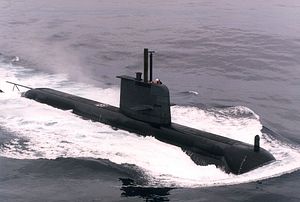Taiwan’s Defense Minister Yang Ming has stated that his Ministry of National Defense (MND) is considering the possibility of independently developing small diesel-electric submarines (SSKs), which would displace between 1500 and 2000 tons. After losing the opportunity to procure SSKs from the U.S. in the 2000s, an insufficient number of SSKs has been a major strategic flaw in Taiwan’s deterrence strategy. Its two Guppy II Class SSKs, of World War II vintage, are for training only, leaving two Dutch Zwaardvis Class vessels obtained in the mid-1980s as its only operational assets. In principle, Taiwan does meet several conditions for indigenous submarine development, such as an established ship-building industry and financial affordability; nevertheless, a range of technical and political factors a likely to hinder the project.
Foreign Reliance
Independent SSK design today is still limited in a few traditional arms exporting countries, such as Russia and Germany. Despite their considerable defense industries, Israel and South Korea both rely on German designs and other technical assistance to develop their own SSKs. For inexperienced Taiwan, a purely independent design would be unrealistic. Yet if Taiwan wants to follow the Israeli or Korean pattern, China would doubtless exert comprehensive diplomatic and economic pressure to block its access to countries that have a submarine industry. After withdrawing its offer, the U.S. seems unlikely to provide a second chance in the near future. Moreover, since the U.S. has not produced any SSK since the 1960s, third-party technology would be necessary and again vulnerable to pressure from Beijing. Japan, which has lifted its ban on arms exports, has the potential to be a supplier of submarine technology, and its own geostrategic considerations may favor a stronger Taiwanese deterrence. However, quite apart from Chinese pressure, Taiwan’s Beijing-friendly policies and endless incidents of Chinese espionage among its armed forces may well dissuade Japan from exporting classified technology.
Budget Constraints
In addition to the technical issues, Taipei faces a challenge with its budget. With an economy among the world’s twenty largest, Taiwan ought to have the resources to invest in a submarine project, but the significance of national defense has gradually decreased, despite serious strategic pressure from China. Since democratization in the early 1990s, the share of Taiwan’s GDP allocated to defense has continuously fallen, dipping below 3 percent in the mid-2000s due to domestic political struggles between the minority government and powerful opposite parties. After the Chinese Nationalist Party (Kuomintang) returned to power in 2008 with a parliamentary majority, it opted to focus on improving relations with China through economic and other integration rather than beefing up national defense.
As a consequence, Taiwan’s defense spending remains below 3 percent of GDP and the number of military projects has declined markedly. Meanwhile, the shift to an all-voluntary military has raised personnel costs, further limiting the funds available for defense investment. Unless policymakers in Taipei radically shift direction, it is unlikely the MND will receive the money for a project as expensive as developing indigenous SSK.
Enough Time?
Even if Taiwan could overcome the technical and budget challenges, building a credible submarine force would be an exceptionally time-consuming exercise. For example, Australia spent more than 15 years developing its flotilla of six Collins Class SSKs, semi-indigenously designed and domestically built. Whether the MND adopts a purely indigenous design or succeeds in obtaining a foreign one, it will still face a series of lengthy tasks including development, trials, modifications and full production. Although Taiwan’s shipbuilding industry has successfully produced frigates, tankers and other types of surface vessels, it’s been four decades since Taiwan built a submarine, and then it was with Italian technical support. Developing the relevant capabilities may thus push the timeframe out even further. Given an increasing military imbalance across the strait, it is doubtful Taiwan can afford to wait that long.
Fait Accompli
Finally, SSKs will not prevent a Chinese fait accompli. In Crimea, Russia’s rapid military deployment created a fait accompli, effectively preventing any Western intervention. China could conceivably do the same, using agents and special troops covered as Chinese tourists, students or businesspeople in Taiwan, aided by airborne divisions backed by its tremendous civil aviation fleets. In that scenario, submarines would be useless. Submarines assume a scenario in which robust Taiwanese resistance withstands missile attacks and air raids, forcing the People’s Liberation Army (PLA) to conduct a naval blockade operation or launch an amphibious invasion. However, recent events suggest that this scenario may no longer be as realistic as once assumed.
As an instrument of defense, SSKs would indeed be valuable for Taiwan, but defense is shaped by politics. And for Taiwan, the politics are likely to evolve too rapidly for a indigenous submarine project to be truly useful for its security.
Shang-su Wu is a research fellow in the Military Studies Programme, a unit of the S. Rajaratnam School of International Studies (RSIS), Nanyang Technological University, Singapore.

































